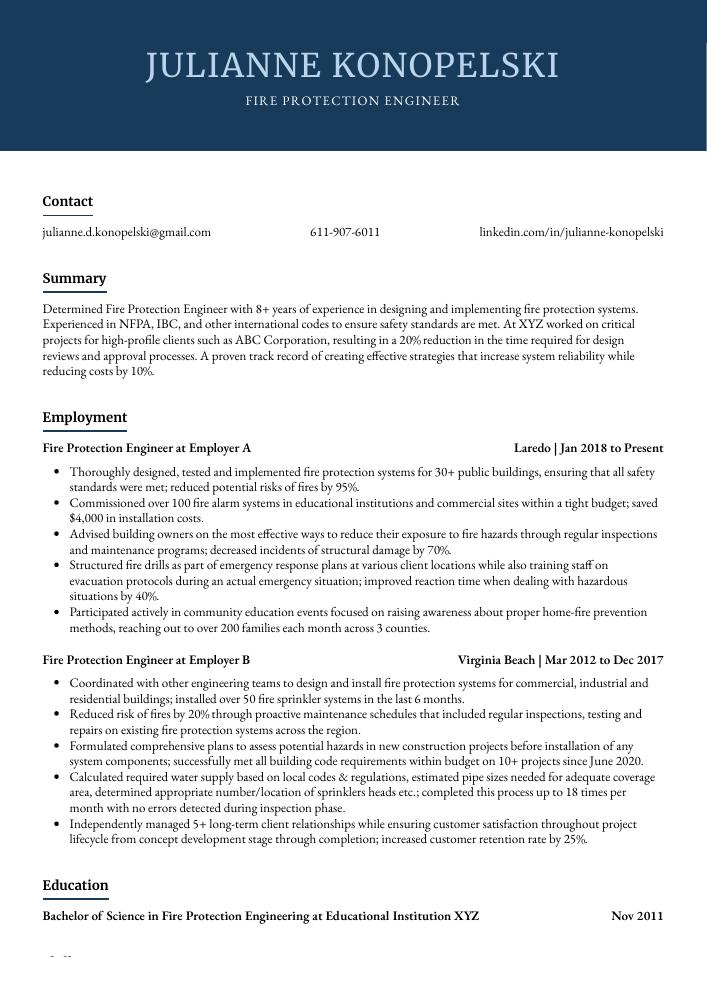Fire Protection Engineer Resume Guide
Fire Protection Engineers are responsible for designing, installing and maintaining systems that protect buildings from fire. They analyze building plans to determine the most effective way of preventing fires by using materials such as automatic sprinklers and smoke detectors, as well as developing evacuation procedures in case of emergency. They also inspect existing fire protection systems in order to identify any potential risks or hazards.
Your expertise in fire safety and protection would be invaluable to any organization. But first, decision-makers must become aware of your qualifications. To make them take notice, you need to create a resume that stands out from the rest.
This guide will walk you through the entire process of creating a top-notch resume. We first show you a complete example and then break down what each resume section should look like.
Table of Contents
The guide is divided into sections for your convenience. You can read it from beginning to end or use the table of contents below to jump to a specific part.
Fire Protection Engineer Resume Sample
Julianne Konopelski
Fire Protection Engineer
[email protected]
611-907-6011
linkedin.com/in/julianne-konopelski
Summary
Determined Fire Protection Engineer with 8+ years of experience in designing and implementing fire protection systems. Experienced in NFPA, IBC, and other international codes to ensure safety standards are met. At XYZ worked on critical projects for high-profile clients such as ABC Corporation, resulting in a 20% reduction in the time required for design reviews and approval processes. A proven track record of creating effective strategies that increase system reliability while reducing costs by 10%.
Experience
Fire Protection Engineer, Employer A
Laredo, Jan 2018 – Present
- Thoroughly designed, tested and implemented fire protection systems for 30+ public buildings, ensuring that all safety standards were met; reduced potential risks of fires by 95%.
- Commissioned over 100 fire alarm systems in educational institutions and commercial sites within a tight budget; saved $4,000 in installation costs.
- Advised building owners on the most effective ways to reduce their exposure to fire hazards through regular inspections and maintenance programs; decreased incidents of structural damage by 70%.
- Structured fire drills as part of emergency response plans at various client locations while also training staff on evacuation protocols during an actual emergency situation; improved reaction time when dealing with hazardous situations by 40%.
- Participated actively in community education events focused on raising awareness about proper home-fire prevention methods, reaching out to over 200 families each month across 3 counties.
Fire Protection Engineer, Employer B
Virginia Beach, Mar 2012 – Dec 2017
- Coordinated with other engineering teams to design and install fire protection systems for commercial, industrial and residential buildings; installed over 50 fire sprinkler systems in the last 6 months.
- Reduced risk of fires by 20% through proactive maintenance schedules that included regular inspections, testing and repairs on existing fire protection systems across the region.
- Formulated comprehensive plans to assess potential hazards in new construction projects before installation of any system components; successfully met all building code requirements within budget on 10+ projects since June 2013.
- Calculated required water supply based on local codes & regulations, estimated pipe sizes needed for adequate coverage area, determined appropriate number/location of sprinklers heads etc.; completed this process up to 18 times per month with no errors detected during inspection phase.
- Independently managed 5+ long-term client relationships while ensuring customer satisfaction throughout project lifecycle from concept development stage through completion; increased customer retention rate by 25%.
Skills
- Fire Protection
- Engineering
- AutoCAD
- Fire Safety
- Life Safety
- Fire Alarm
- NFPA
- Fire Suppression Systems
- Fire Protection Engineering
Education
Bachelor of Science in Fire Protection Engineering
Educational Institution XYZ
Nov 2011
Certifications
Certified Fire Protection Specialist
National Fire Protection Association
May 2017
1. Summary / Objective
A resume summary for a fire protection engineer should highlight your experience in designing and implementing fire safety systems, as well as any certifications or qualifications you have obtained. You could also mention the number of projects you have completed successfully, how many years of experience you have in the field, and any awards or recognition that demonstrate your expertise. This will give employers an overview of why they should consider hiring you for their open position.
Below are some resume summary examples:
Reliable and knowledgeable fire protection engineer with over 3 years of experience in the field. Specializing in designing and evaluating safety systems to meet regulatory requirements, while also providing cost-effective solutions that are compliant with local codes and regulations. At XYZ, improved efficiency by 15% through the optimization of existing sprinkler designs. Committed to ensuring a safe environment for all occupants or visitors regardless of industry type or size.
Dependable fire protection engineer with 8+ years of experience designing, installing and maintaining fire safety systems. Skilled in evaluating building plans to determine the correct design requirements for code compliance. Recognized as a top performer by ABC Tech for achieving 99% on-time completion rate of all projects assigned. Looking to join XYZ Company where I can leverage my expertise and knowledge to ensure fire safety while reducing risk exposure.
Diligent fire protection engineer with 7+ years of experience in designing, evaluating and managing fire safety systems for commercial buildings. Highly experienced in creating emergency plans, inspecting fire prevention equipment and ensuring compliance to the relevant codes & regulations. At XYZ Corporation, led a successful project that reduced potential loss from fires by 62%. Proven ability to assess risks quickly and develop cost-effective solutions.
Well-rounded fire protection engineer with 8+ years of experience designing, installing, and maintaining fire safety systems in a variety of buildings. Proven track record of identifying potential risks and providing solutions to ensure the highest levels of building code compliance. Seeking to join ABC Firm to contribute expertise towards developing comprehensive fire prevention strategies for the company’s clientele.
Enthusiastic fire protection engineer with 8+ years of experience developing strategies and systems to protect against fire. Seeking a position at ABC Fire Protection Services, where I can leverage my expertise in NFPA standards and code requirements to help keep people safe. Most recently reduced the risk of fires in three large buildings by 40%, resulting in an estimated $2 million savings for Company X.
Proficient Fire Protection Engineer with 5+ years of experience in the design and implementation of fire protection systems. Experienced in both residential and commercial structures, including high rises. Recognized for consistently meeting deadlines while keeping safety as a top priority. Specialties include sprinkler system installation, water-based suppression systems and fire alarm monitoring systems.
Hard-working fire protection engineer with 8+ years of experience in designing and installing fire safety systems. Experienced in evaluating existing structures to determine suitability for use, as well as developing strategies to reduce the risk of fire-related incidents. Skilled at using a wide range of software programs, including AutoCAD and Revit. Familiarity with NFPA codes and standards.
Amicable fire protection engineer with 5+ years of experience designing, analyzing and managing fire safety systems. Seeking to join ABC Fire Protection Services to ensure the highest level of safety for clients through state-of-the-art installations and maintenance. In previous roles, designed multiple commercial projects that passed all relevant codes while staying within budget.
2. Experience / Employment
The employment (or experience) section is where you list your work history. It should be written in reverse chronological order, which means the most recent job is listed first.
Stick to bullet points primarily when writing this section; it makes it easier for the reader to take in what you have to say quickly and efficiently. When talking about what you did, provide detail and explain any quantifiable results that were achieved as a result of your efforts.
For example, instead of saying “Designed fire protection systems,” you could say, “Developed detailed designs for fire suppression systems using AutoCAD software while adhering to NFPA codes and standards resulting in successful installation of all projects.”
To write effective bullet points, begin with a strong verb or adverb. Industry specific verbs to use are:
- Designed
- Installed
- Inspected
- Certified
- Monitored
- Evaluated
- Calculated
- Analyzed
- Programmed
- Troubleshot
- Fabricated
- Commissioned
- Upgraded
- Documented
- Tested
Other general verbs you can use are:
- Achieved
- Advised
- Assessed
- Compiled
- Coordinated
- Demonstrated
- Developed
- Expedited
- Facilitated
- Formulated
- Improved
- Introduced
- Mentored
- Optimized
- Participated
- Prepared
- Presented
- Reduced
- Reorganized
- Represented
- Revised
- Spearheaded
- Streamlined
- Structured
- Utilized
Below are some example bullet points:
- Evaluated fire protection systems in over 50 buildings, ensuring compliance with the National Fire Protection Association standards and achieving a 95% success rate in fire safety certification.
- Documented specifications for fire alarm control panels, sprinkler systems and smoke detectors; revised designs to reduce installation cost by $15,000 while maintaining code requirements.
- Assessed potential hazard areas of commercial properties using heat-sensing cameras and predictive computer models to recommend corrective measures that decreased risk of fires by 45%.
- Successfully installed 40+ emergency lighting fixtures across multiple sites according to established industry guidelines within two months under budget constraints ($5K).
- Conducted regular maintenance inspections on existing equipment such as extinguishers and water supply lines, decreasing malfunctions due to wear & tear by 36%.
- Streamlined fire safety processes for multiple projects, resulting in a 25% reduction of fire protection engineering costs.
- Facilitated the installation and maintenance of fire alarm systems, sprinkler systems, smoke control systems and other emergency response equipment to ensure compliance with local codes and regulations.
- Accurately evaluated building plans & blueprints to identify potential risks associated with hazardous materials; developed detailed reports outlining recommended changes for improved safety measures.
- Improved existing procedures by creating an automated system that monitored all fire suppression devices across various sites; increased efficiency by 40%.
- Tested new products such as flame retardants and conducted periodic inspections on existing installations; decreased occurrence of false alarms by 50%.
- Demonstrated expertise in designing and implementing fire safety systems, reducing risk of injury or property damage by up to 50%.
- Mentored junior engineers on the principles of fire protection engineering; supervised 10+ interns who went on to secure positions at reputable firms within 6 months.
- Developed comprehensive plans for installing sprinkler systems and alarm systems across various commercial buildings, saving clients over $5,000 in installation costs.
- Expedited approval process for projects requiring local government permits – reduced paperwork time from 3 weeks to 2 days without compromising quality standards.
- Reliably provided prompt response & troubleshooting services 24/7 when called upon; averted a major crisis situation due to malfunctioning smoke alarms at an industrial building with 1,500 people inside safely evacuated within 15 minutes.
- Actively monitored fire safety systems across 85+ buildings, inspecting and testing sprinkler heads, pumps, alarms and other equipment to ensure they conformed with all applicable codes and regulations.
- Reorganized the layout of critical components in 25 high-risk properties by adding additional smoke detectors, replacing outdated wiring systems and installing new fire doors; reduced incidences of false alarms by 34%.
- Installed 10 automated fire suppression units at various locations according to NFPA standards; organized training sessions for personnel on proper use & maintenance procedures resulting in a 15% reduction in emergency response times over six months.
- Prepared detailed hazard assessments for 20 different sites based on building construction type & occupancy load along with environmental factors like weather conditions; designed customized evacuation plans that saved time during drills while also raising employee awareness levels about potential risks associated with fires or explosions.
- Represented the company at numerous industry events such as conferences, seminars and trade shows which helped build strong relationships within the business community while promoting awareness of up-to-date Fire Protection Engineering principles among attendees.
- Fabricated fire protection systems utilizing state-of-the-art technology while adhering to all relevant fire safety codes, resulting in a 10% reduction of installation time.
- Programmed and maintained automated fire alarm systems onsite; successfully implemented upgrades that improved system efficiency by 15%.
- Competently inspected sprinkler heads, risers and other components of the building’s fire suppression equipment regularly; identified potential hazards before they became an issue, reducing emergency repairs by 25%.
- Troubleshot malfunctions in existing systems quickly and accurately using problem solving skills; reduced average repair time from 8 hours to 5 hours per incident.
- Compiled extensive reports detailing assessments performed on each project site for internal use as well as client reference documents upon completion of projects; decreased documentation errors by 20%.
- Optimized fire protection systems for over 100 commercial buildings, resulting in improved safety standards and a decrease of fire-related incidents by 15%.
- Certified to design, install and inspect fire sprinkler systems according to NFPA 13D codes; successfully designed 5+ installations within the last year.
- Spearheaded the development and implementation of an evacuation plan at 3 multi-storey office complexes that was approved by local authorities ahead of schedule.
- Upgraded existing alarm system components across 10 sites with modern technologies such as heat detectors, smoke alarms & closed circuit TV cameras; reduced response times during emergency situations by 50%.
- Meticulously reviewed each element within building plans to ensure they were compliant with state regulations on fire prevention requirements before approving them for construction purposes; saved $50K in unnecessary costs throughout the process.
- Designed fire protection systems for over 40 industrial, commercial and residential buildings; reduced budget costs by 15%.
- Proficiently worked with CAD software to develop fire safety plans and drawings for a wide range of projects.
- Presented comprehensive reports on system performance, code analysis & risk assessment findings to senior management in a clear and concise manner.
- Monitored installation progress of sprinkler systems, fire alarms & extinguishers at several sites across the city; completed inspections within 5 days or less without any delays or errors reported.
- Utilized advanced knowledge of building codes and NFPA regulations to ensure that all installations were compliant with industry standards at all times; improved safety ratings by 25% during annual reviews conducted by external agencies.
- Introduced and implemented fire protection systems and protocols to over 30 facilities, ensuring compliance with state regulations and reducing the risk of potential fires by 25%.
- Analyzed current building designs in order to identify weaknesses that could lead to a fire hazard; achieved an 89% success rate in pinpointing possible risks before they materialized.
- Inspected existing sprinkler systems for defects or improperly installed components on a weekly basis, saving up $10K/year in repair costs due to early detection of system issues.
- Substantially increased safety standards at commercial buildings across four states through comprehensive training programs for staff members; reduced injury incidents caused by fires from 5 per quarter to zero over one year period.
- Achieved 95% customer satisfaction rating among clients by promptly responding to emergency calls within two hours, guaranteeing top-notch service regardless of time constraints.
3. Skills
Skill requirements will differ from employer to employer – this can easily be determined via the job advert. Organization ABC might be looking for someone with expertise in fire safety systems, while Organization XYZ might require knowledge of sprinkler system design.
You want to tailor the skills section of your resume to each job that you are applying for as many employers use applicant tracking systems these days, which are computer programs that scan resumes for certain keywords before passing them on to a human.
Once listed here, it is important to discuss these qualifications further in other sections such as the summary or experience section. This will help demonstrate how your skill set can benefit the company and make you stand out from other applicants.
Below is a list of common skills & terms:
- Alarm Systems
- AutoCAD
- BIM
- Building Codes
- CAD
- Code Enforcement
- Commissioning
- Computer Aided Design
- Construction Management
- Contract Management
- Emergency Management
- Emergency Services
- Engineering
- Engineers
- Fire Alarm
- Fire Management
- Fire Protection
- Fire Protection Engineering
- Fire Safety
- Fire Sprinkler Systems
- Fire Suppression Systems
- Firefighting
- HVAC
- Hazard Recognition
- Hazardous Materials
- Inspection
- Life Safety
- MATLAB
- MEP
- Mechanical Engineering
- NFPA
- Nuclear
- Plan Review
- Project Engineering
- Project Planning
- Public Safety
- Revit
- Risk Assessment
- SOLIDWORKS
- Submittals
- Teamwork
4. Education
Including an education section on your resume will depend on how far along you are in your career. If you just graduated and have no work experience, mention your education below the objective statement. However, if you already have a few years of experience under your belt or plenty to showcase from past roles, it might be best to omit an education section altogether.
If an education section is included, try to focus on courses related to fire protection engineering that demonstrate knowledge relevant for the job role being applied for.
Bachelor of Science in Fire Protection Engineering
Educational Institution XYZ
Nov 2011
5. Certifications
Certifications are a great way to demonstrate your expertise in a particular field. They can also show potential employers that you have taken the initiative to stay up-to-date with industry trends and advancements.
If you are certified in any skill related to the job you are applying for, make sure it is included on your resume as this could be an important factor when deciding who gets hired.
Certified Fire Protection Specialist
National Fire Protection Association
May 2017
6. Contact Info
Your name should be the first thing a reader sees when viewing your resume, so ensure its positioning is prominent. Your phone number should be written in the most commonly used format in your country/city/state, and your email address should be professional.
You can also choose to include a link to your LinkedIn profile, personal website, or other online platforms relevant to your industry.
Finally, name your resume file appropriately to help hiring managers; for Julianne Konopelski, this would be Julianne-Konopelski-resume.pdf or Julianne-Konopelski-resume.docx.
7. Cover Letter
Writing a cover letter is an important part of the job application process. It’s a great opportunity to make yourself stand out from other candidates and show why you’re the perfect fit for the role.
Cover letters should be between 2 to 4 paragraphs long, and include information that isn’t already mentioned in your resume. They allow you to express more personality than what is typically seen on resumes, as well as provide recruiters with deeper insights into who you are as a professional.
Below is an example cover letter:
Dear Lavinia,
I am writing to apply for the Fire Protection Engineer position with Smith and Sons Consulting. I am a licensed professional engineer with four years of experience in the fire protection engineering field. In my current role, I work with clients to design fire suppression systems that meet their needs and budget.
My experience has given me a strong understanding of local, state, and national fire codes. I have also gained valuable experience performing site visits to assess existing fire protection systems and make recommendations for improvements. I am confident that I can use my skills and knowledge to benefit your company and contribute to its success.
In addition to my technical skills, I have excellent communication and interpersonal skills. This enables me to effectively communicate with clients, architects, engineers, code officials, and other stakeholders involved in a project. My ability to develop positive relationships is an asset in sales situations as well as when working on projects where coordination between multiple disciplines is required.
I look forward to speaking with you about this opportunity further during an interview at your earliest convenience.
Sincerely,
Julianne
Fire Protection Engineer Resume Templates
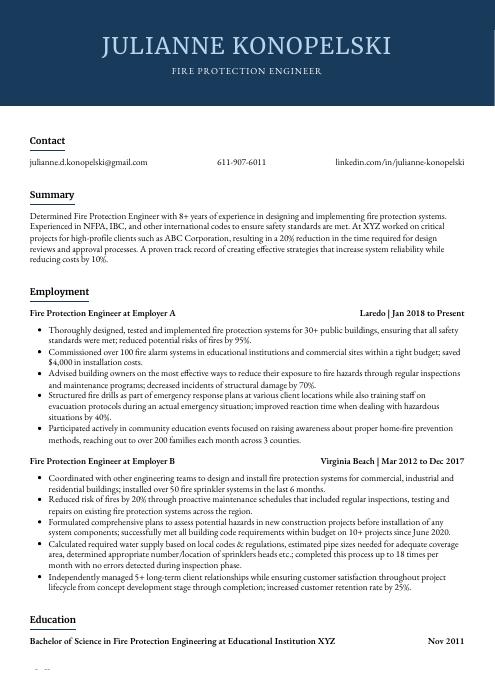 Bonobo
Bonobo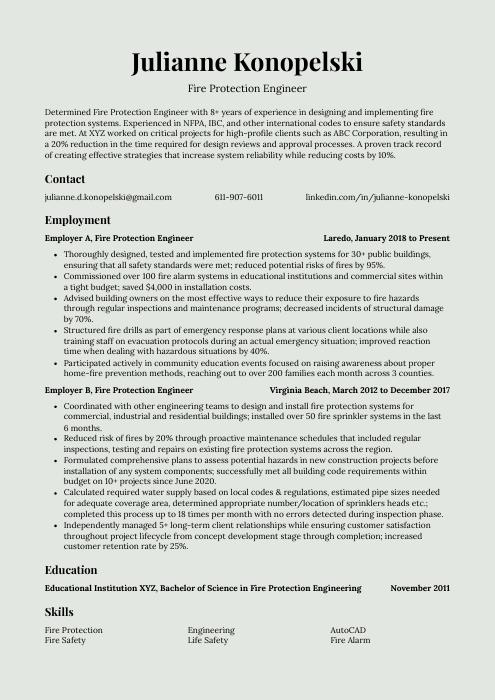 Saola
Saola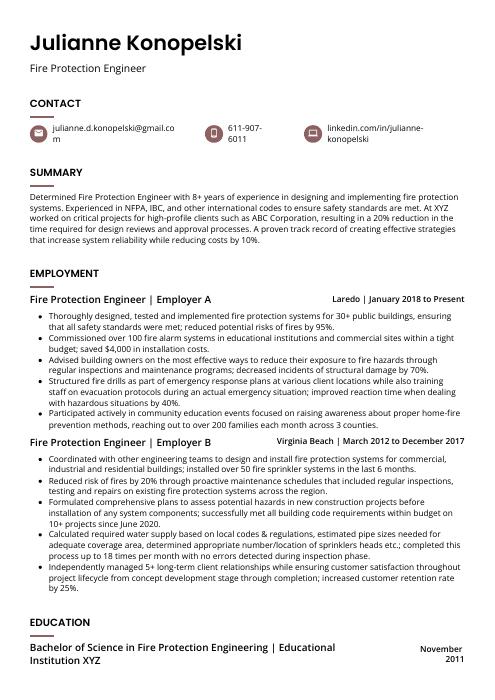 Fossa
Fossa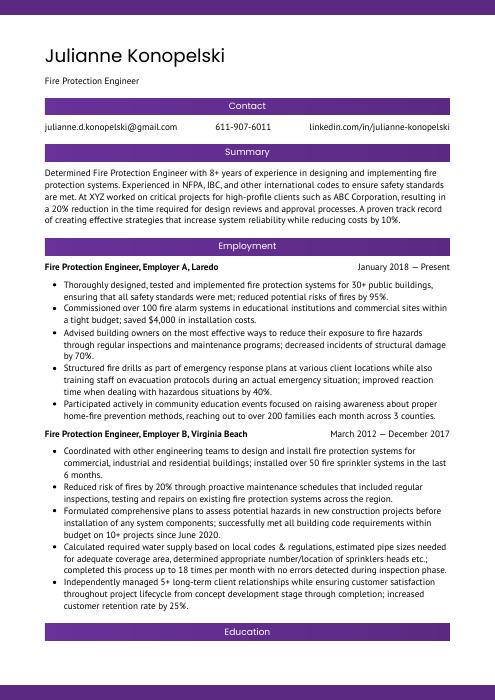 Jerboa
Jerboa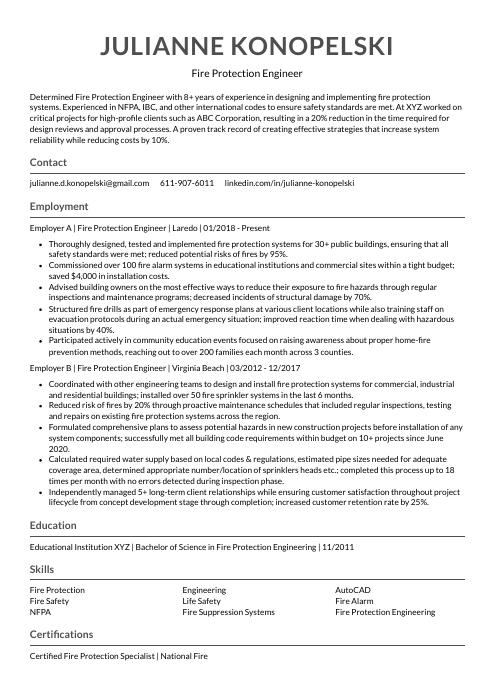 Indri
Indri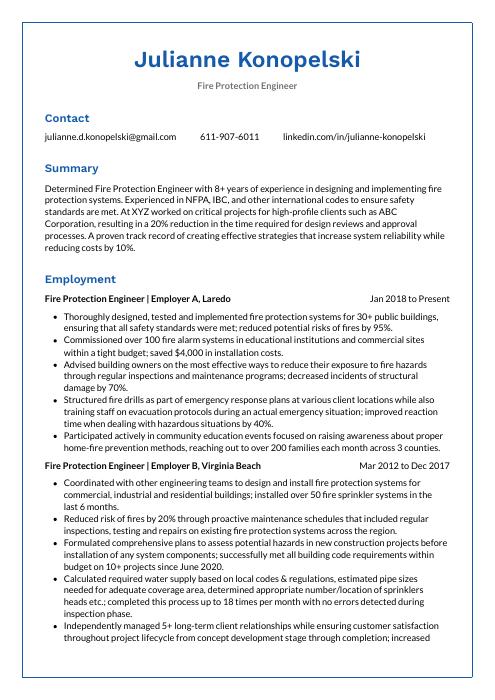 Markhor
Markhor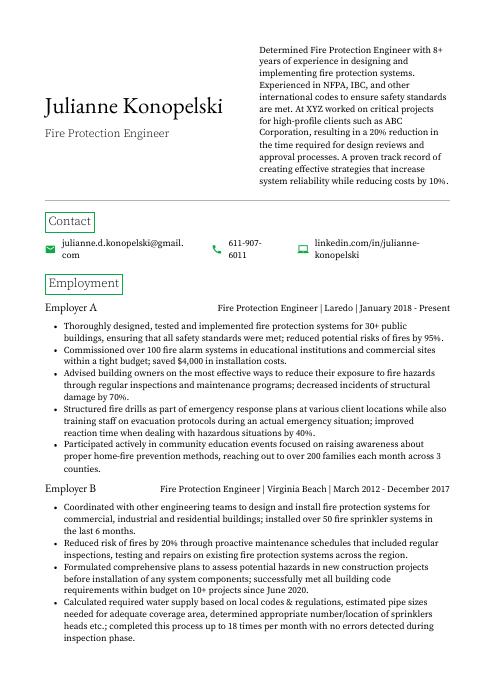 Quokka
Quokka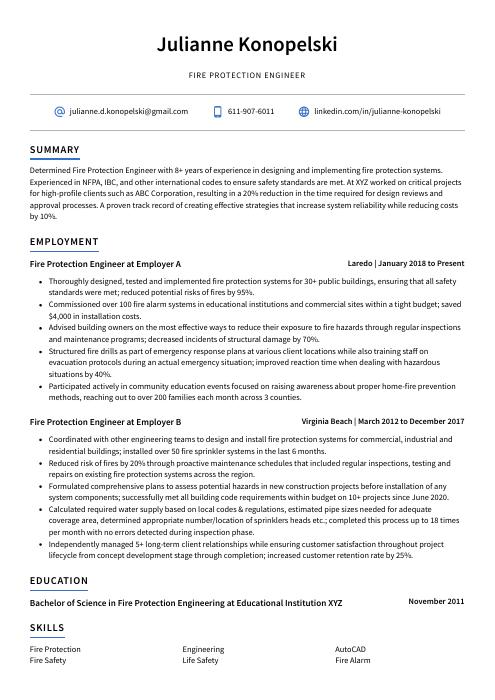 Axolotl
Axolotl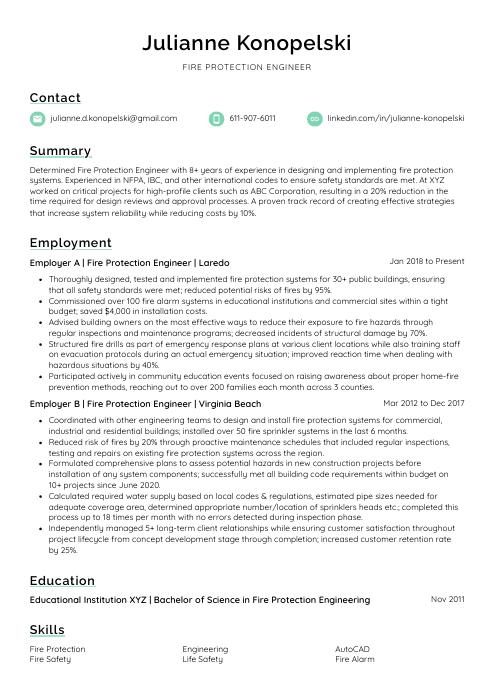 Lorikeet
Lorikeet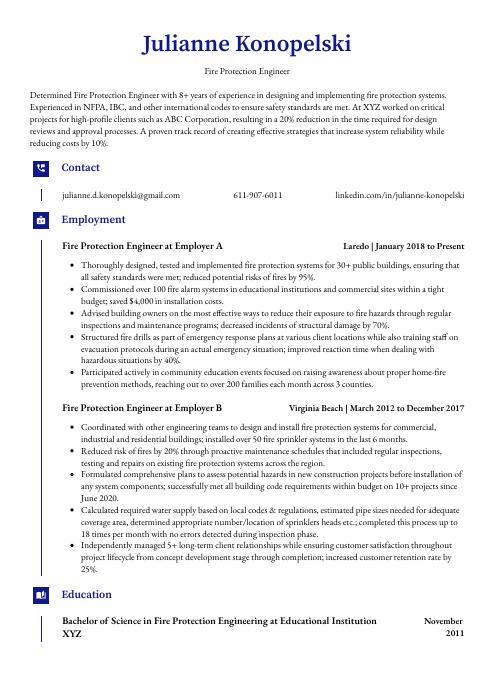 Gharial
Gharial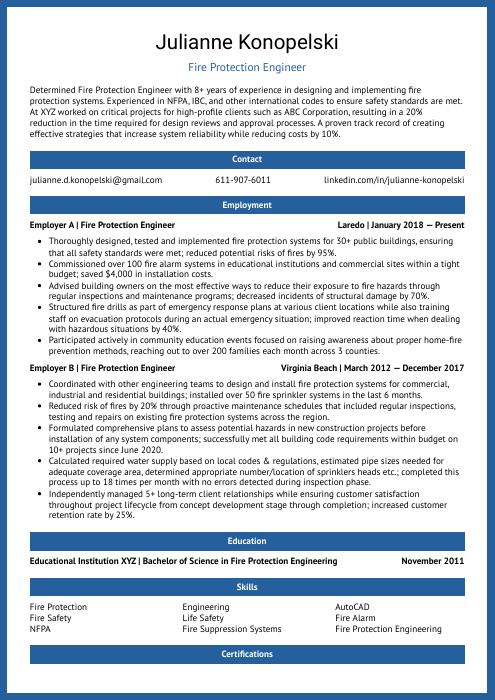 Ocelot
Ocelot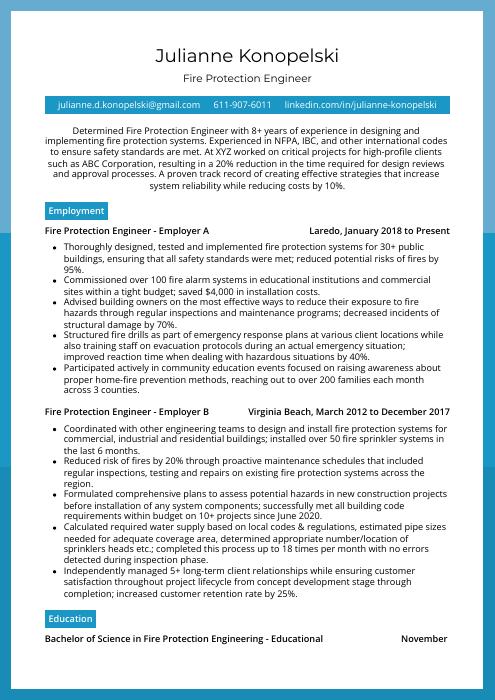 Rhea
Rhea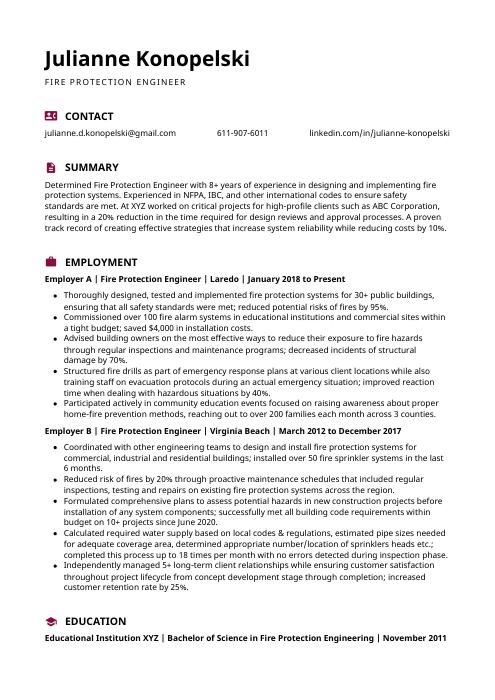 Hoopoe
Hoopoe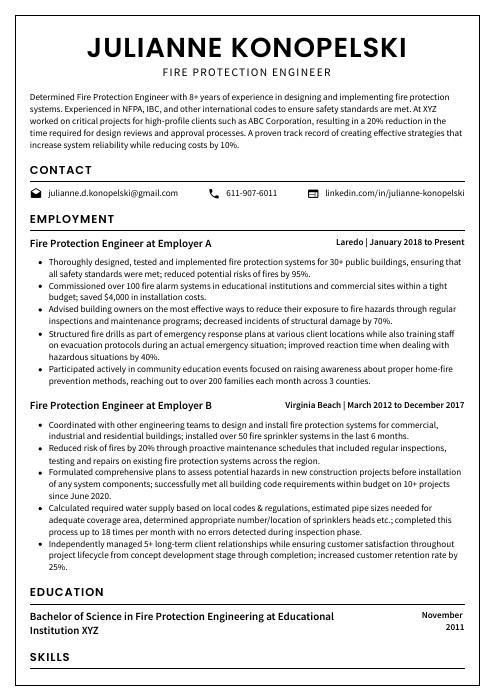 Cormorant
Cormorant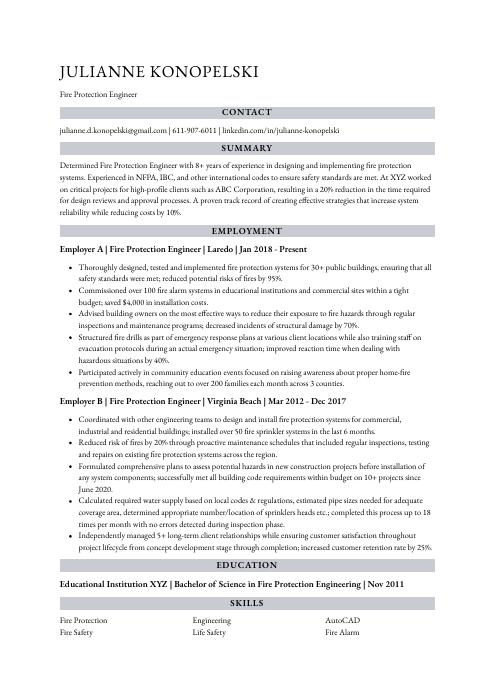 Numbat
Numbat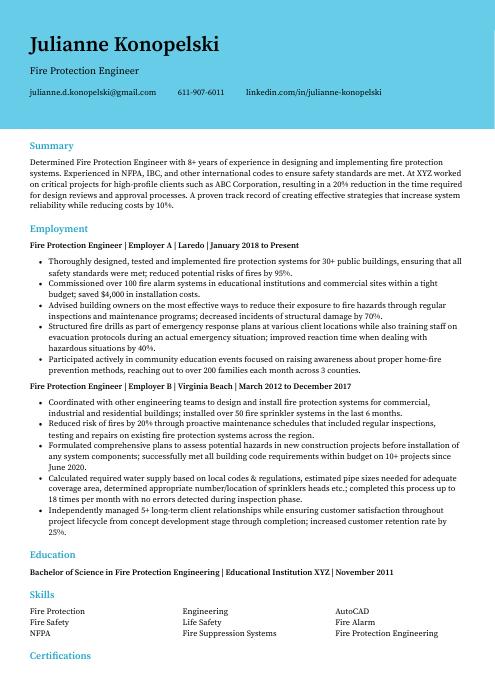 Dugong
Dugong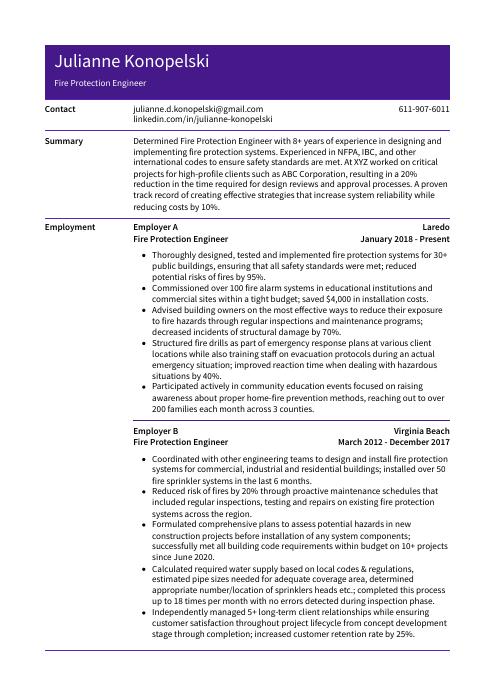 Pika
Pika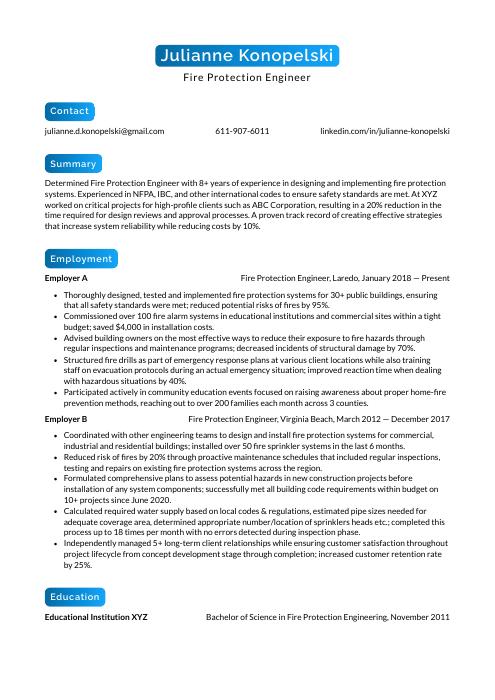 Kinkajou
Kinkajou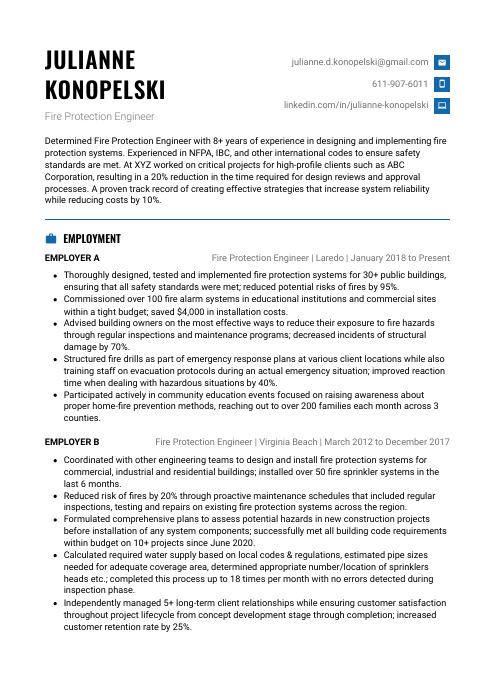 Echidna
Echidna Rezjumei
Rezjumei
